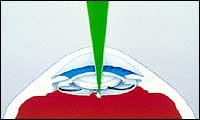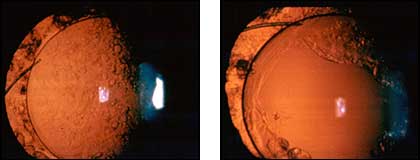Posterior capsulotomy is a laser surgical procedure which is sometimes necessary to clear vision after cataract surgery. During cataract surgery, the cloudy lens inside the eye is removed and replaced with a clear artificial lens implant. The cataract is surrounded by a clear cellophane-like wrapping. During cataract surgery, the front cellophane wrapping is removed. Then the cataract is removed and the implant placed. The back cellophane wrapping (known as the posterior capsule) remains intact. In some people, months or even years after cataract surgery, this clear cellophane membrane becomes cloudy. Subsequently, laser treatment is done to restore vision.
Symptoms
Decrease in vision is the main symptom which begins anywhere from a few months to many years after cataract surgery. Also, increased difficulty with glare and bright lights as well as decreased ability to read and see far distances.
Treatment
Treatment involves a brief two minute procedure in which a laser is used to create an opening in the clouded membrane. A laser is a focused beam of light. The procedure is completely painless and is completed with numbing eye drops. There are no eye drops to use after the procedure and most patients resume all normal activity immediately. Most patients notice an improvement in vision within the first day or two.

An invisible laser (shown in green) is focused onto the cloudy membrane behind the lens implant where a small hole is created. This allows light to pass freely to the retina and thereby improves vision.

Above Left: The circular object is the lens implant. A small spring-like device is at the left of the implant. Behind the lens is a cloudy membrane. The cloudy haze can be seen through the center of the lens implant. Above Right: A hole in the center of the cloudy membrane is seen through the lens implant. Since light can now pass easily, vision is improved.